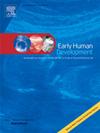使用功能MRI评估自发性早产前胎儿胸腺。
IF 2
3区 医学
Q2 OBSTETRICS & GYNECOLOGY
引用次数: 0
摘要
目的:本研究的目的是利用T2*松弛法(一种定量组织氧合的间接方法)来评估整个妊娠期间无并发症妊娠和随后早产的胎儿队列中的胎儿胸腺。方法:招募低风险妊娠的对照组,如果扫描后出现任何妊娠相关并发症,则回顾性排除。参与者被认为在妊娠32周之前分娩的风险很高,如果在妊娠32周之前没有分娩,则回顾性地排除。所有参与者都在包含胎儿胸部的3t系统上进行了胎儿MRI扫描。将T2和T2*数据对齐,测定胸腺组织平均T2*。结果:对照胎儿(n = 49)平均胸腺T2*随妊娠而降低。在妊娠32周之前分娩的胎儿中(n = 15),与对照组相比,胸腺体积减少,平均T2* (p≤0.001)。这一发现在PPROM患者的亚组分析中持续存在(p = 0.002),尽管在膜完整的患者中没有(p = 0.067)。结论:这些数据表明,极端早产前胸腺灌注可能减少,并且先进的MRI技术有可能更好地询问体内早产儿前的胎儿免疫变化。本文章由计算机程序翻译,如有差异,请以英文原文为准。
Assessment of the thymus in fetuses prior to spontaneous preterm birth using functional MRI
Objectives
The aim of this study was to utilise T2* relaxometry (an indirect method of quantifying tissue oxygenation) to assess the fetal thymus in uncomplicated pregnancies throughout gestation and in a cohort of fetuses that subsequently deliver very preterm.
Methods
A control group of participants with low-risk pregnancies were recruited and retrospectively excluded if they developed any pregnancy related complications after scanning. Participants were recruited who were deemed to be at very high risk of delivery prior to 32 weeks' gestation and retrospectively excluded if they did not deliver prior to this gestation. All participants underwent a fetal MRI scan on a 3 T system incorporating the fetal thorax. T2 and T2* data were aligned and the mean T2* of the thymus tissue determined.
Results
Mean thymus T2* decreased with gestation in control fetuses (n = 49). In fetuses who went on to deliver prior to 32 weeks' gestation (n = 15), thymus volume was reduced as was mean T2* (p ≤ 0.001) as compared to controls. This finding persisted in a subgroup analysis of participants with PPROM (p = 0.002), although not in those with intact membranes (p = 0.067).
Conclusion
These data demonstrates both a likely reduction in perfusion of the thymuses prior to extreme preterm birth, and also the potential for advanced MRI techniques to better interrogate the fetal immune changes prior to preterm birth in vivo.
求助全文
通过发布文献求助,成功后即可免费获取论文全文。
去求助
来源期刊

Early human development
医学-妇产科学
CiteScore
4.40
自引率
4.00%
发文量
100
审稿时长
46 days
期刊介绍:
Established as an authoritative, highly cited voice on early human development, Early Human Development provides a unique opportunity for researchers and clinicians to bridge the communication gap between disciplines. Creating a forum for the productive exchange of ideas concerning early human growth and development, the journal publishes original research and clinical papers with particular emphasis on the continuum between fetal life and the perinatal period; aspects of postnatal growth influenced by early events; and the safeguarding of the quality of human survival.
The first comprehensive and interdisciplinary journal in this area of growing importance, Early Human Development offers pertinent contributions to the following subject areas:
Fetology; perinatology; pediatrics; growth and development; obstetrics; reproduction and fertility; epidemiology; behavioural sciences; nutrition and metabolism; teratology; neurology; brain biology; developmental psychology and screening.
 求助内容:
求助内容: 应助结果提醒方式:
应助结果提醒方式:


